Top Rankings
Troy Area School District ranks among the top 20% of public school district in Pennsylvania for:
Category
Attribute
Student Attention
Lowest student:teacher ratio (Top 1%)
For the 2025 school year, there is 1 public middle school serving 654 students in Troy Area School District. This district's average middle testing ranking is 4/10, which is in the bottom 50% of public middle schools in Pennsylvania.
Public Middle School in Troy Area School District have an average math proficiency score of 25% (versus the Pennsylvania public middle school average of 26%), and reading proficiency score of 50% (versus the 52% statewide average).
Minority enrollment is 5% of the student body (majority Hispanic and Black), which is less than the Pennsylvania public middle school average of 46% (majority Black and Hispanic).
Overview
This School District
This State (PA)
# Schools
3 Schools
923 Schools
# Students
1,399 Students
591,579 Students
# Teachers
145 Teachers
44,337 Teachers
Student : Teacher Ratio
10:1
10:1
District Rank
Troy Area School District, which is ranked within the bottom 50% of all 675 school districts in Pennsylvania (based off of combined math and reading proficiency testing data) for the 2021-2022 school year.
The school district's graduation rate of 85-89% has stayed relatively flat over five school years.
Overall District Rank
#484 out of 684 school districts
(Bottom 50%)
(Bottom 50%)
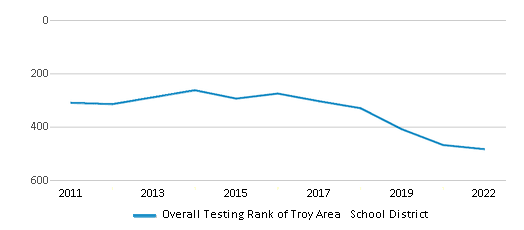
Math Test Scores (% Proficient)
23%
36%
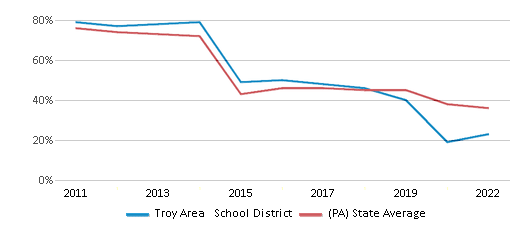
Reading/Language Arts Test Scores (% Proficient)
48%
55%
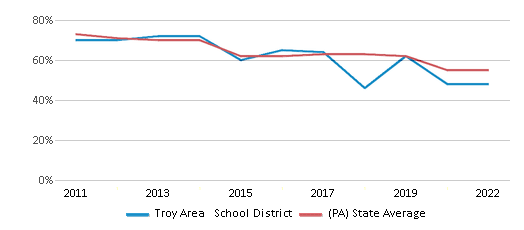
Science Test Scores (% Proficient)
65%
57%
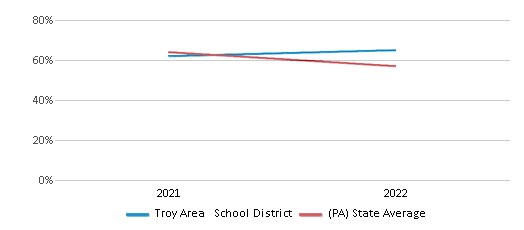
Graduation Rate
85-89%
87%
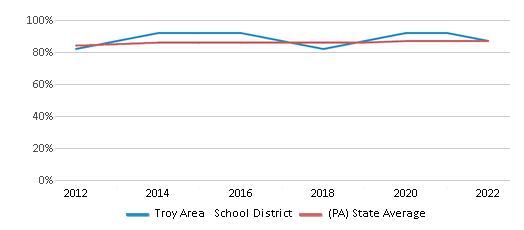
Students by Ethnicity:
Diversity Score
0.09
0.65
# American Indian Students
2 Students
1,239 Students
% American Indian Students
n/a
n/a
# Asian Students
10 Students
25,214 Students
% Asian Students
1%
4%
# Hispanic Students
26 Students
97,970 Students
% Hispanic Students
2%
17%
# Black Students
8 Students
118,593 Students
% Black Students
1%
20%
# White Students
1,335 Students
316,870 Students
% White Students
95%
54%
# Hawaiian Students
n/a
586 Students
% Hawaiian Students
n/a
n/a
# Two or more races Students
18 Students
30,545 Students
% of Two or more races Students
1%
5%
Students by Grade:
# Students in PK Grade:
-
1,623
# Students in K Grade:
102
15,933
# Students in 1st Grade:
109
17,465
# Students in 2nd Grade:
103
18,204
# Students in 3rd Grade:
92
18,156
# Students in 4th Grade:
109
19,235
# Students in 5th Grade:
112
33,809
# Students in 6th Grade:
118
92,720
# Students in 7th Grade:
114
128,929
# Students in 8th Grade:
111
129,773
# Students in 9th Grade:
115
34,725
# Students in 10th Grade:
109
28,504
# Students in 11th Grade:
122
26,584
# Students in 12th Grade:
83
25,919
# Ungraded Students:
-
-
District Revenue and Spending
The revenue/student of $19,462 in this school district is less than the state median of $23,696. The school district revenue/student has stayed relatively flat over four school years.
The school district's spending/student of $19,221 is less than the state median of $23,119. The school district spending/student has stayed relatively flat over four school years.
Total Revenue
$27 MM
$39,541 MM
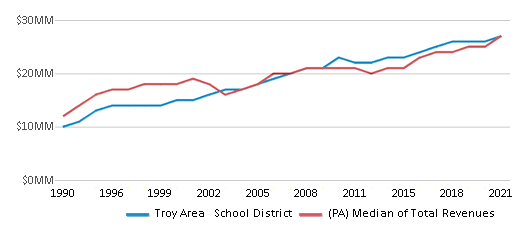
Spending
$27 MM
$38,578 MM
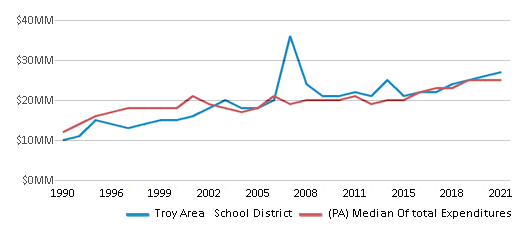
Revenue / Student
$19,462
$23,696
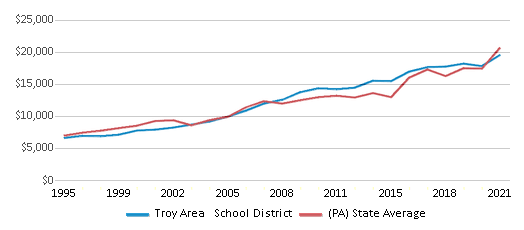
Spending / Student
$19,221
$23,119
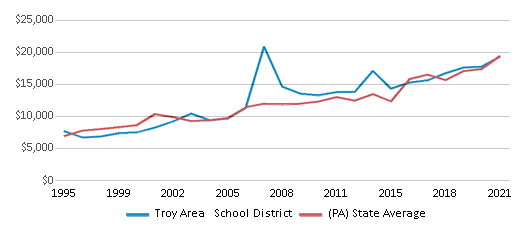
Best Troy Area School District Public Middle Schools (2025)
School
(Math and Reading Proficiency)
(Math and Reading Proficiency)
Location
Grades
Students
Rank: #11.
Troy Area Jr. Sr. High School
(Math: 25% | Reading: 50%)
Rank:
Rank:
3/
Bottom 50%10
150 High St
Troy, PA 16947
(570) 297-2176
Troy, PA 16947
(570) 297-2176
Grades: 7-12
| 654 students
Recent Articles

What Is A Charter School?
Explore the world of charter schools in this comprehensive guide. Learn about their history, how they operate, and the pros and cons of this educational innovation. Discover key facts about charter schools, including admission policies, demographics, and funding, as well as what to look for when considering a charter school for your child.

10 Reasons Why High School Sports Benefit Students
Discover the 10 compelling reasons why high school sports are beneficial for students. This comprehensive article explores how athletics enhance academic performance, foster personal growth, and develop crucial life skills. From improved fitness and time management to leadership development and community representation, learn why participating in high school sports can be a game-changer for students' overall success and well-being.

February 05, 2025
Understanding the U.S. Department of Education: Structure, Impact, and EvolutionWe explore how the Department of Education shapes American education, from its cabinet-level leadership to its impact on millions of students, written for general audiences seeking clarity on this vital institution.





